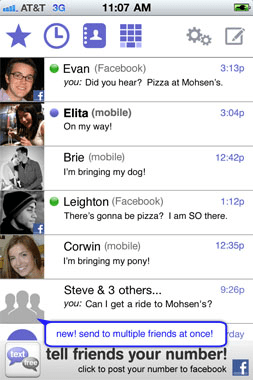Turns out you don’t have to charge an arm and a leg for SMS messages to make money off of texting.
One startup that’s proven this is Pinger, the company behind the massively popular free texting app Textfree. Today, the company is announcing that it’s reached a major milestone: since launching in March 2009, Textfree users have sent and received a total of 20 billion text messages. For free. And they’re sending and receiving another 1.5 billion messages every month (they were growing at 1 billion per month in March of this year).
Textfree is so popular because it gives users free texting to and from — here’s the important bit — their own, unique phone numbers. Fire up the app for the first time and you’ll be given a new phone number that people can text the same way they would any other mobile number. Textfree is available for both iOS and Android, and it’s particularly popular on devices like the iPod Touch, which wouldn’t otherwise have full texting functionality (the iOS version also offers free and low-cost phone calls, which will be released on the Android version down the line). Pinger makes money via advertising.
Because of the huge text volume and number of installs, Pinger also gets some compelling insight into the trends being seen across the smartphone market — particularly among younger users who can’t afford a traditional SMS plan. Pinger CEO Greg Woock says that when the service’s many iPod Touch users do eventually upgrade to a ‘real’ phone, more often than not they’re choosing an Android device instead of an iPhone. This is likely because Android handsets are generally less expensive (yes, the iPhone 3GS is now ‘free’ with a contract, but from a performance perspective a ‘free’ Android device is likely going to be significantly faster).
Another key stat: Android use across Textfree’s service has now equaled iOS — and the Android version of Textfree has only been out half as long and doesn’t include voice functionality yet. In other words, Android is growing fast.
Woock also reports an encouraging trend for Textfree’s service: after around nine months or so of using Textfree, users become attached to their Textfree number, and are very likely to keep using it in the long-term.
